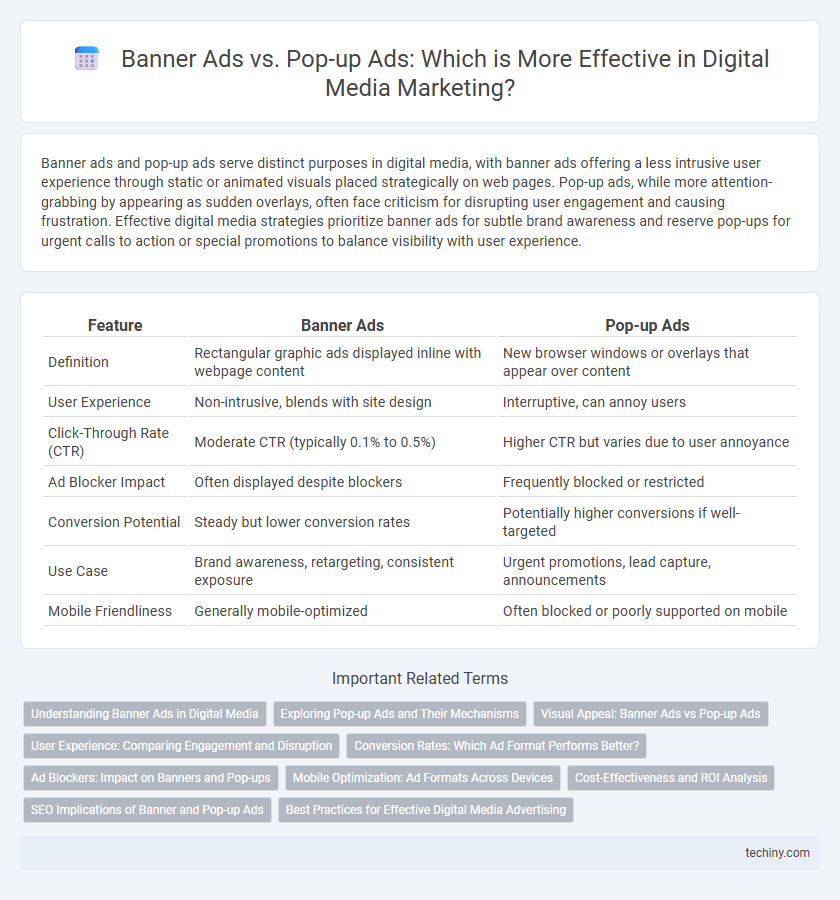Banner ads and pop-up ads serve distinct purposes in digital media, with banner ads offering a less intrusive user experience through static or animated visuals placed strategically on web pages. Pop-up ads, while more attention-grabbing by appearing as sudden overlays, often face criticism for disrupting user engagement and causing frustration. Effective digital media strategies prioritize banner ads for subtle brand awareness and reserve pop-ups for urgent calls to action or special promotions to balance visibility with user experience.
Table of Comparison
| Feature | Banner Ads | Pop-up Ads |
|---|---|---|
| Definition | Rectangular graphic ads displayed inline with webpage content | New browser windows or overlays that appear over content |
| User Experience | Non-intrusive, blends with site design | Interruptive, can annoy users |
| Click-Through Rate (CTR) | Moderate CTR (typically 0.1% to 0.5%) | Higher CTR but varies due to user annoyance |
| Ad Blocker Impact | Often displayed despite blockers | Frequently blocked or restricted |
| Conversion Potential | Steady but lower conversion rates | Potentially higher conversions if well-targeted |
| Use Case | Brand awareness, retargeting, consistent exposure | Urgent promotions, lead capture, announcements |
| Mobile Friendliness | Generally mobile-optimized | Often blocked or poorly supported on mobile |
Understanding Banner Ads in Digital Media
Banner ads in digital media are rectangular graphic display ads that appear embedded within web pages, designed to attract user attention while maintaining site aesthetics. These ads leverage targeted keywords and user data to enhance relevance and click-through rates, making them a preferred choice for brand awareness campaigns. Compared to pop-up ads, banner ads offer a less intrusive user experience, contributing to higher engagement and lower bounce rates.
Exploring Pop-up Ads and Their Mechanisms
Pop-up ads function by opening a new browser window or tab, capturing users' immediate attention with dynamic content. These ads often use JavaScript or browser extensions to trigger based on user behavior, such as time spent on a page or exit intent, increasing engagement potential. Despite their intrusive reputation, optimized pop-up ads can enhance conversion rates when integrated with targeted messaging and precise timing strategies.
Visual Appeal: Banner Ads vs Pop-up Ads
Banner ads maintain visual appeal through consistent, non-intrusive placement that integrates seamlessly with website content, enhancing user engagement without disrupting navigation. Pop-up ads, while more attention-grabbing due to their sudden appearance, often detract from the user experience by obscuring content and causing frustration. Effective banner ad design leverages vibrant imagery and clear calls-to-action, whereas pop-up ads rely on timing and frequency to balance visibility and user tolerance.
User Experience: Comparing Engagement and Disruption
Banner ads offer a less intrusive user experience by seamlessly integrating into webpage layouts, promoting higher engagement through visually appealing graphics and clear calls-to-action. Pop-up ads, while often capturing immediate attention, tend to disrupt navigation flow, leading to increased bounce rates and negative user sentiment. Studies indicate that banner ads maintain longer session durations, whereas pop-ups frequently cause user frustration and ad-blocker activation.
Conversion Rates: Which Ad Format Performs Better?
Banner ads generally achieve higher conversion rates compared to pop-up ads due to their less intrusive nature and better user experience. Studies indicate that banner ads can increase click-through rates by up to 0.35%, whereas pop-up ads often face higher dismissal rates, reducing their effectiveness. Optimizing banner ad placement and design significantly enhances conversion rates, making them a preferred choice in digital media campaigns.
Ad Blockers: Impact on Banners and Pop-ups
Banner ads generally face lower blockage rates compared to pop-up ads, as pop-ups are more intrusive and thus more frequently targeted by ad blockers like AdBlock Plus and uBlock Origin. Research shows that approximately 70% of pop-up ads are blocked on major browsers, whereas banner ads experience a blockage rate closer to 30%, affecting overall reach and engagement metrics. Advertisers must consider these differences when optimizing digital campaigns to minimize ad blocker impact and maximize visibility.
Mobile Optimization: Ad Formats Across Devices
Banner ads offer seamless integration within mobile apps and websites, providing non-intrusive user experiences optimized for various screen sizes and orientations. Pop-up ads, often disruptive on mobile devices, may hinder usability and result in higher bounce rates due to smaller screen real estate and sensitivity to touch inputs. Mobile optimization favors adaptive banner ad formats that enhance engagement while maintaining page load speed and user retention across diverse devices.
Cost-Effectiveness and ROI Analysis
Banner ads offer higher cost-effectiveness by delivering better ROI through targeted audience engagement and longer visibility periods compared to pop-up ads. Pop-up ads often generate lower conversion rates due to their intrusive nature, resulting in reduced overall return on investment. Analyzing metrics such as click-through rates (CTR) and cost per acquisition (CPA) reveals banner ads as a more efficient strategy for maximizing digital advertising budgets.
SEO Implications of Banner and Pop-up Ads
Banner ads enhance SEO by increasing user engagement and driving targeted traffic without severely disrupting page load speed, thereby improving site rankings. Pop-up ads often negatively impact SEO due to higher bounce rates and slower page performance, as search engines penalize intrusive user experiences. Optimizing ad placement and ensuring mobile responsiveness are critical for maintaining SEO value while leveraging both banner and pop-up ads in digital media strategies.
Best Practices for Effective Digital Media Advertising
Banner ads perform best when placed strategically above the fold with clear calls to action and visually cohesive branding, enhancing user engagement without disrupting the browsing experience. Pop-up ads require precise timing, relevance to user behavior, and easy exit options to minimize intrusiveness and maximize conversion rates. Combining A/B testing with analytics-driven insights ensures optimal placement and design, improving click-through rates and overall campaign ROI in digital media advertising.
Banner Ads vs Pop-up Ads Infographic

 techiny.com
techiny.com